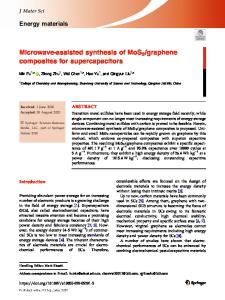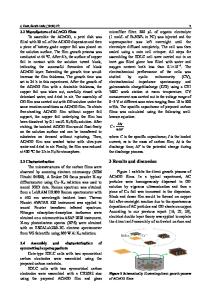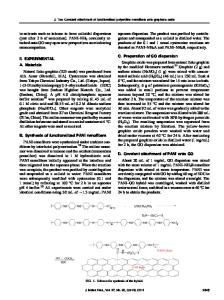Hierarchical construction of polyaniline nanorods on sulfonated graphene for high-performance supercapacitors
- PDF / 2,107,715 Bytes
- 9 Pages / 595.276 x 790.866 pts Page_size
- 57 Downloads / 366 Views
Hierarchical construction of polyaniline nanorods on sulfonated graphene for high-performance supercapacitors Yunlong Li1,2 · Yuying Zheng2 Received: 22 January 2018 / Accepted: 3 April 2018 © Springer Science+Business Media, LLC, part of Springer Nature 2018
Abstract Herein, polyaniline (PANI)/sulfonated graphene (SG) hierarchical composites was prepared through the growth of polyaniline nanorods on the surface of SG. The morphology and structure of the composites were analyzed by scanning electron microscopy, fourier transform infrared spectroscopy, raman spectroscopy, X-ray diffraction and X-ray photoelectron spectroscopy. It was found that SG was beneficial to the form of uniform PANI nanorods, and strong interactions could be formed between them. Due to the synergistic effect between PANI and SG, The SG/PANI composite electrode exhibited excellent electrochemical performances, especially extraordinarily high-rate capability. When the current density increased to 50 A g−1, SG/PANI with 81.5% PANI presented a high specific capacitance of 477.5 F g−1, which remained 86.3% of its initial value at 0.5 A g−1. The cycle life test show the composites have excellent stability (still remain 96.7%) after 2000 cycles. Moreover, an asymmetric supercapacitor was assembled coupling with graphene, which demonstrated remarkable specific energy density and power density simultaneously. The highest values could achieve 56.34 Wh kg−1 and 1200 W kg−1.
1 Introduction Supercapacitors, also known as electrochemical capacitors, have attracted intense interests in energy storage due to its high power density and long cycle life [1, 2]. From the perspective of charge storage, there are two main classes of supercapacitors: (a) electrical double-layer capacitors (EDLCs), whose capacitance arises from the charge separation at the electrode/electrolyte interface and (b) pesudocapacitors with the pseudocapacitance arises from redox reactions occurring at or inside the interface of electrode (approximately 5 nm) [3, 4]. In comparison, pesudocapaeitors present much higher capacitance than that of EDLCs. The performance index of supercapacitors is greatly determined by the category and structure of electrode materials Electronic supplementary material The online version of this article (https://doi.org/10.1007/s10854-018-9037-9) contains supplementary material, which is available to authorized users. * Yuying Zheng [email protected] 1
Department of Light‑Textile Engineering, Liming Vocational University, Quanzhou 362000, China
College of Materials Science and Engineering, Fuzhou University, 2 Xueyuan Road, Fuzhou 350116, China
2
[5, 6]. Therefore, it is extremely important to regulate and control the morphological and structural characteristics of electrode materials to construct high-performance supercapacitors [7, 8]. Among the conductive polymer pseudocapacitive materials, polyaniline (PANI) is considered the most promising material because of its high capacitive characteristics, low cost, and ease of synthesis [9–13]. Howeve
Data Loading...











